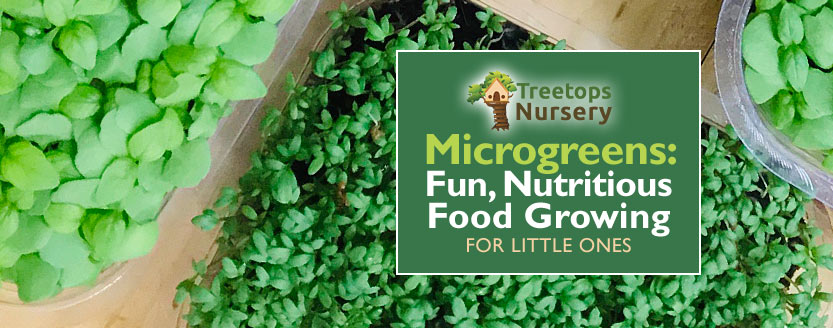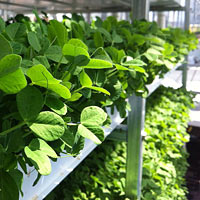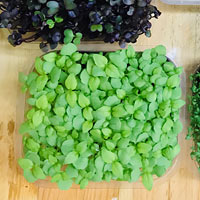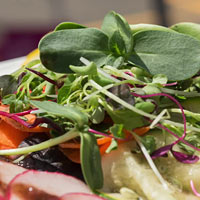
 There is one class of edible plant that can be grown all year round and is perfect for kids to grow indoors, for example on a windowsill. Some types of this food will sprout in as little as a week. What’s more, it’s tasty and highly nutritious. Growing it is super-easy and a perfect way to keep kids entertained, educated about nature and eating healthily. It’ll also be a welcome addition to mealtimes for the whole household.
There is one class of edible plant that can be grown all year round and is perfect for kids to grow indoors, for example on a windowsill. Some types of this food will sprout in as little as a week. What’s more, it’s tasty and highly nutritious. Growing it is super-easy and a perfect way to keep kids entertained, educated about nature and eating healthily. It’ll also be a welcome addition to mealtimes for the whole household.
Growing Microgreens
We’re talking about Microgreens (also referred to as micro leaves). These are the early, edible, sprouting leaves of very young herbs, leafy greens and some root vegetables that might usually be thought of in a larger, more mature form. The tender new leaves are cut just days after they first sprout and can be made into wonderful salads, garnishes or meal accompaniments. They also bring some very tasty flavours to mealtimes. The young micro leaves are full of vitamins and minerals, look fantastic on the plate and will grow back time and time again after snipping. The secret is simply to harvest the immature micro leaves and to stop them from growing to full size. Just harvest … re-harvest … and re-harvest.
“Micro leaves are usually eaten fresh and raw, and the fresher the leaves are, the more vitamins and minerals they contain. Each little leaf is a gold mine of vitamins, antioxidants and minerals such as iron, folic acid and potassium.” (Gardeners World)
 Here are just a few examples of plants that make suitable microgreens and can easily be grown by children indoors:
Here are just a few examples of plants that make suitable microgreens and can easily be grown by children indoors:
- Basil — their tasty baby leaves are full of flavour and can be harvested just ten days after seed planting. They’re wonderful on salads, pizzas and can even be made into pesto sauce.
- Coriander — their tiny, delicate leaves pack a unique and punchy flavour that’s perfect with salads, stir-fries, chopped onions and curries. They can be harvested a couple of weeks after sowing the seeds.
- Rocket — ready to harvest just a week after first sowing, rocket microgreens are another flavoursome and slightly peppery leaf to add to salads and put onto pizzas. Very tasty!
- Mustard leaves — these may not be to every child’s taste, but many adults will enjoy the slight heat they’ll bring to salads, stir fries and Eastern dishes. Ready to first harvest in 1 to 2 weeks.
 Fennel — just 10 days after first sprouting, leaves from young fennel seedlings will give a pleasant aniseed tang to dishes like pasta salads, risottos, soups and even stuffing.
Fennel — just 10 days after first sprouting, leaves from young fennel seedlings will give a pleasant aniseed tang to dishes like pasta salads, risottos, soups and even stuffing.- Beetroot leaves — the sprouting microgreen leaves from the beetroot take just ten days to appear after sowing. With their rich green leaves and red stems, they look wonderful in salads and lend their mild, earthy flavour to garnishes for some fish dishes.
- Radish leaves — in just a week, the young, fiery leaves from the radish seedlings will be ready to snip and add to salads, stir fries and sandwiches. For some, their microgreen leaves are even tastier than the traditional root.
- Spinach — tender leaves from young spinach plants can be harvested in ten days or so. They’re really good for you too. With their mild flavour, they’re a perfect addition to leafy salads, risottos, pastas and noodles.
- Broccoli leaves — these will be ready to first harvest in just a week and have quite a different flavour than their fully-grown counterpart. With their slightly spicy taste, they’re also great in salads, risottos and omelettes.
 Red Cabbage micro leaves have one of the highest Vitamin C concentrations of any microgreen. They also contain Vitamin K, potassium, beta-carotene, calcium, magnesium and antioxidants. As with many of the microgreens, many top chefs use them as an attractive and tasty garnish. They can be sprinkled over soups, salads, grilled vegetables, stews and cooked meats. After sowing, they take only days to appear.
Red Cabbage micro leaves have one of the highest Vitamin C concentrations of any microgreen. They also contain Vitamin K, potassium, beta-carotene, calcium, magnesium and antioxidants. As with many of the microgreens, many top chefs use them as an attractive and tasty garnish. They can be sprinkled over soups, salads, grilled vegetables, stews and cooked meats. After sowing, they take only days to appear.
How children can grow microgreens at home
Your children will need very little to get started. You’ll need to buy them some packet seeds, which you can get at your local garden nursery or online. If you’re unsure who to order from online, Suttons are probably the best-known supplier and seed packets there seem to start from as little as just a pound or two. You can also find mixed seed packets. (If you’re on a really tight budget, you can alternatively take a look at the excellent post about growing food virtually free of cost, by our sister nursery in Streatham).
Along with the seeds, your child will need some multi-purpose or seed and cuttings compost (peat-free is more eco-friendly) and something to sow the seeds in. If you’re going to grow the microgreens on the windowsill, you could use flower pots, slim seed trays (perhaps left over from plants or herbs you have previously bought), containers, yoghurt pots with drainage holes pierced underneath, egg cartons, or even the cardboard cores from used kitchen rolls, cut down to a suitable size. Any of these will need something to sit in, to catch any draining water, for example a saucer or seed ‘drip tray’.
 Your child will need to fill the chosen containers with compost, not quite to the top. Tap it to level the soil, then pat it down just a little to firm it. Some gardeners also indent the compost where the seeds will go. The seeds then need to be carefully placed or lightly sprinkled into the indented areas. It’s important that your child spaces the seeds out so there is no clumping, otherwise significant problems can occur (the crop might get diseased or even completely fail). The seeds don’t need to be covered but a light dusting of sieved compost will keep them in place while allowing light to get through. The seeds then need to be lightly watered. It’s best for your child to do this part outside, just to avoid potential mess indoors, taking care not to over-water nor to wash the seeds away. A way to water them indoors is to simply stand the vessels in some shallow water for 30 to 60 minutes, so the compost naturally draws up the moisture.
Your child will need to fill the chosen containers with compost, not quite to the top. Tap it to level the soil, then pat it down just a little to firm it. Some gardeners also indent the compost where the seeds will go. The seeds then need to be carefully placed or lightly sprinkled into the indented areas. It’s important that your child spaces the seeds out so there is no clumping, otherwise significant problems can occur (the crop might get diseased or even completely fail). The seeds don’t need to be covered but a light dusting of sieved compost will keep them in place while allowing light to get through. The seeds then need to be lightly watered. It’s best for your child to do this part outside, just to avoid potential mess indoors, taking care not to over-water nor to wash the seeds away. A way to water them indoors is to simply stand the vessels in some shallow water for 30 to 60 minutes, so the compost naturally draws up the moisture.
The rest is also very easy. Your child simply needs to place the potted seeds on a light windowsill and ensure that the compost is always kept damp, taking care not to over-water. Also consider a label for each pot for identification purposes, particularly if several different seed types have been planted. Some people cover the seed pots or trays with a single sheet of kitchen towel, newspaper or even cling film to keep the moisture in while the seeds initially germinate. Your child will need to check under the covering every day. The moment little shoots can be seen, the covering will need to be removed, so long as the soil is kept moist thereafter, so it never dries out. Ensure the potted plants get full light and ventilation too. Within a week or two depending on the seeds chosen, the young shoots will grow baby leaves and can then be harvested. Snip them near their bases before mature leaves start to replace the baby leaves. If you want to benefit from them for longer, snip them like this rather than pulling up their roots, so they can sprout and re-sprout time and time again.
Eat & enjoy!
 Once rinsed, the tender young micro leaves can be enjoyed in meals by the whole family. They’ll add often exquisite tastes and textures to meals as well as adding much-needed vitamins and minerals to the family diet. That’s even more important for growing toddlers and preschoolers, of course. And, throughout the growing journey, the children will absolutely love seeing the new shoots grow into young plants. They will have learnt new skills, had great fun getting to know more about nature and have a real sense of achievement. Chances are, too, that they will love the taste of the micro leaves.
Once rinsed, the tender young micro leaves can be enjoyed in meals by the whole family. They’ll add often exquisite tastes and textures to meals as well as adding much-needed vitamins and minerals to the family diet. That’s even more important for growing toddlers and preschoolers, of course. And, throughout the growing journey, the children will absolutely love seeing the new shoots grow into young plants. They will have learnt new skills, had great fun getting to know more about nature and have a real sense of achievement. Chances are, too, that they will love the taste of the micro leaves.
Treetops Nursery in Willesden
We hope you and your family enjoyed this article and will have fun growing your very own microgreens. The post was brought to you by Treetops Day Nursery in Willesden, London NW10. We are a childcare nursery and pre-school, suitable for babies from 6 months and children up to 5 years of age. We’re also convenient for parents and carers who are looking for high quality weekday childcare near Willesden Green, Harlesden, Brent, Kensal Green, Brondesbury Park, Kilburn, Mapesbury, Dollis Hill, Church End, Roundwood, College Park and Park Royal. Please do get in touch if you’d like to learn more about a possible nursery place for your child.
For further details, contact Treetops Nursery:

